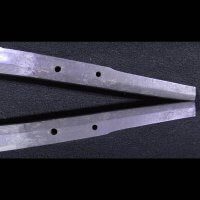Nihonto Antique Tachi
Tachi - The first sword of the samurai
Since the first tachi was made over a thousand years ago, it has shaped the history of the Japanese sword.
The original samurai sword is the tachi. You can buy tachi with history from us.
Showing the single result
Showing the single result
Buy Tachi at japan-budo.com
More than just a big sword
![]() =Tachi: literally means big sword. This is why it is usually translated as "great sword".
=Tachi: literally means big sword. This is why it is usually translated as "great sword".
As it is larger than the much better known Katana, the translation is not wrong either.
But you have to bear in mind that the characters can also be translated as "great sword". This better captures the reverence and respect that is shown towards these swords.
Because of the history of this sword, it is highly prized and extremely popular in Japan.
What makes antique tachi THE samurai sword?
When the samurai came to power, they decided that single-edged curved swords should be their main swords.
That was around the 10th century in Japan. Back then, the samurai mainly fought on horseback and needed long, massive swords.
It was the tachi that became the first true samurai swords. For a long time, they were the undisputed number 1 among samurai swords.
It was the first samurai sword, which became their trademark.
In addition to its importance on the battlefield, it was also a welcome gift and compulsory clothing at court.
This is why there are many very elaborately decorated and splendid examples. The mounts (koshirae) were generally somewhat more ornate than on the swords that followed.
The ashi and the associated components required to carry the sword with the edge pointing downwards on the belt make for a striking appearance.
As tachi existed long before the katana, the term daisho was used to describe the combination of this long sword and the katana. Tanto.
Over the centuries, through Taira, Minamoto, Ashikaga and all the other leaders, the samurai kept this one sword until the 17th century.
Centuries of battles and struggles in Japan. Including 2 invasion attempts by Mongolian troops.
The more manoeuvrable and faster katana was already known and popular from the 14th century onwards, but the actual samurai sword still lasted a good 200 years.
In the peacetime Edo period, long swords really went out of fashion and when Western countries discovered their enthusiasm for Japan from the 19th century onwards, the tachi was almost forgotten.
This is probably why the katana is so well known here, although the actual, real sword of the samurai was the tachi.
Buy antique tachi in our online shop
Unfortunately, antique tachi are often not as highly regarded in the West as their little brother, the katana.
As the ancient swords have been around since the early days of the samurai, many of them are also very old. Nevertheless, these swords were still forged by Japanese swordsmiths for a long time, as described above.
We also endeavour to offer an interesting range in this area.
You can therefore also buy antique tachi in our online shop, with the usual quality and familiar service.
We would also like to be a reliable partner for you
You may have noticed that the importance of Tachi is otherwise less emphasised. This is because it is much more profitable for sellers to simply go along with the hype surrounding Katana.
Of course you can also get antique katana from us if you are looking for it. But we at least try to give you an acceptable overall impression of the whole subject.
But be careful, we don't do this without ulterior motives!
We would like to become a reliable partner for you, with whom you can travel together through the world of the Japanese sword.
That's why we try to give you as much information as possible for this trip, so that you can not only benefit from our offer, but also take something away for yourself.
The offers on this website are subject to differential taxation in accordance with Section 25a of the German VAT Act. We therefore pay VAT separately. This is noted on the invoices. For formal reasons, the products are labelled incl. VAT, which in this case means incl. 0% VAT.

